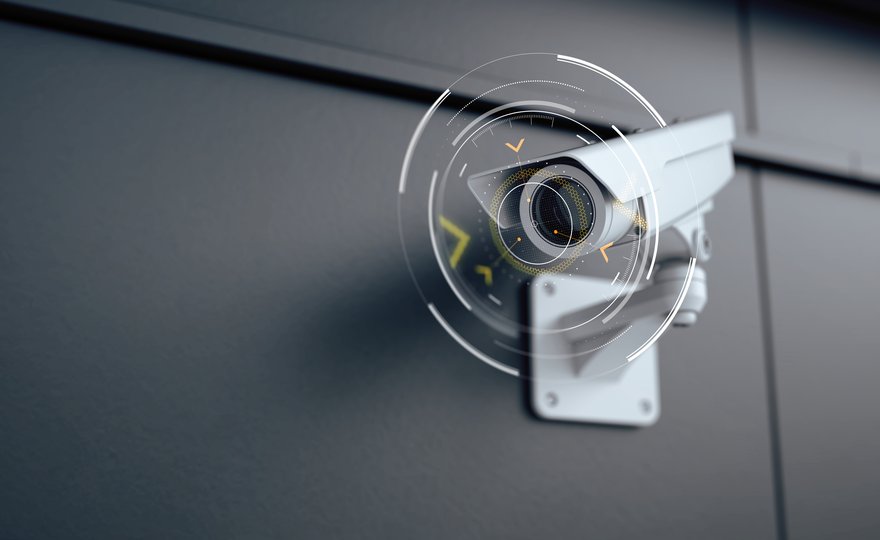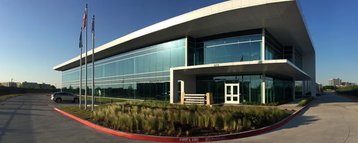Data centers are capital-intensive developments, often costing hundreds of millions of dollars.
Many developers will say that means there’s little left over to beautify buildings which generally look to stay out of the public gaze.
Data center naysayers will argue, however, that there must surely be room to spend a tiny percentage of that huge spend on making them less dystopian in appearance, if nearby residents have to look at these buildings day in, day out, for the next 20+ years.
As awareness of, and opposition to, data centers grows in many key markets, local communities and regulators are demanding developers make more of an effort to soften the rough edges of data centers and make them look less like windowless prisons in exchange for granting planning permission.
But can data center developers balance the increasing aesthetic demands with the security requirements customers need?
Aesthetic demands increase
While some data centers can be very aesthetically pleasing, these are often retrofits of historical buildings in major metros. 60 Hudson in New York City may be among the most iconic examples.
Most older sites are merely retrofits of bland offices or warehouses. And many older purpose-built facilities show little aesthetic flair and are simply large grey windowless concrete boxes surrounded by heavy fencing. This was accepted for years when data centers were few and far between but, as data centers increase in number across many markets, they have become a blight for some communities.
“When this business started, we used existing logistic [facilities] and old office buildings that we converted into data centers,” says Digital Realty’s chief data center technology and engineering officer, Lex Coors. “Then we started to build two-floor, three-floor, four-floor, or five-floor data center blocks. And then we got pushback and the authorities saying, ‘You're just greying the whole area with blocks. Can you not make them look a little better?’”
This has led to the growing trend of adding glass facades to data centers to make them more office-like in appearance, but this is more common in areas where local planning rules require it. As data centers continue to proliferate, the demands around visually appealing facilities are increasing.
Operators are choosing a variety of colors for their buildings, including green living walls (also known as vertical gardens), or even painting murals on the sides of buildings. Many are starting to add LEDs that change color depending on the time of year to add a night-time aesthetic.
“It's a conversation and a cooperation with the local authorities. We listen to the issue that the local authority wants to solve, and we explain to them the issue of some of their requirements,” says Coors. “But we will not compromise our security regardless of aesthetics.”
David Watkins, solutions director of European operator Virtus, notes that regulations have become tighter, but says operators still benefit from the security that obscurity can provide in many locations.
“In an ideal world, we sit in the background and do the critical stuff that we do without drawing attention,” he says. “Most people that come past our campus here in Stockley Park probably don't even know that they are data centers.
“But that's a key driver for us moving forward; to make sure we meet our commitments in terms of planning, but also to make our buildings look secure and professional rather than secure and overbearing.”
Mary Hart, practice leader, mission critical at architecture and design firm HKS, notes that hiding in plain sight is taking a step back to company promotion.
“Branding is a big thing now. They're not necessarily trying to hide; they still want to convey a sense of security, but they are also conveying a brand and selling a product, especially the colos,” she says.
“You can see if they've spent money trying to make it a little bit better. But we also have some clients where their model is not to spend any more money than they have to because it’s all going into the infrastructure.”
And as facilities get taller, the effort to make data centers look more like offices can be an opportunity to push back against the dirge of big grey boxes.
“The big squat buildings are hard to upgrade aesthetically; it's always going to be a big flat warehouse-looking building,” says Hart. “You can dress up the facade quite a bit, but it's hard to break up those really long linear facades into something that is more aesthetically attractive without spending a ton of money to do so.”
What’s in there?
Compliance and regulation will always play a key part in data center security. Fences, gates, guardhouses, and CCTV will always be required as industry standards demand. But the more ‘in your face’ a company is about security, the more it risks becoming a lure.
“I've looked at sites in the past where the prison analogy is a good one; they've had barbed wire or spikes on the top of the fence, and it all looks very secure,” says Virtus’ Watkins. “But the downside of that is you're attracting attention. People will ask what's in there because we do not publicize what we do.”
The first thing to note when designing a data center is where it is going to be and what types of buildings it will be neighboring.
“It really starts right at the beginning when we're looking at sites,” says Watkins. “Even where we put them is a security consideration; we will do a very extensive due diligence exercise involving surveys, and local searches around what businesses are nearby.”
It’s important to make your facility blend in with what’s around you. A glass-covered building in an office district makes sense.
Likewise, a welcoming facade sits well in a residential area. But looking super secure in a residential spot or too inviting in an industrial park can be incongruous and attract interest.
“It would be weird to see this exotic building landmark in an industrial area because we would be the only ones, and that's what you don't want,” says Digital’s Coors.
DataBank’s CISO Mark Houpt notes that, generally, his company tries to avoid making facilities look too much like warehouses as it may invite opportunistic thieves. Instead, the company tries to make them more office-like.
“Data centers can be large boxy facilities that look like warehouses,” he says. “But that, in itself, can attract people because they may think that there's material inside that they can break and enter and walk away with. In Plano, for example, the facility looks like a warehouse on the back end of it, but the front we've made look like an office building with big windows.”
Telehouse South – the company’s latest facility in London – is housed in a former Thompson Reuters building along the Thames riverside in east London’s Docklands. The company is confident enough in its security procedures that it is actually opening up a public pedestrian path along the riverside at the backside of its property.
Paul Lewis, Telehouse SVP of technical services, told DCD on a recent tour of the facility that the company is deploying smart CCTV that can detect, count, and monitor people loitering the edge of the facility, but such physical attacks are incredibly rare.
Rather than targeting data, the threat the company is more likely to see is opportunistic intruders trying to steal equipment or sellable materials such as copper.
Virtus’ Watkins also noted that increasingly smart CCTV cameras mean that fewer are needed around the site as they can, like Telehouse, detect people hanging around close to the campus, which also has a public waterside path on one side. Likewise, tremble detection on fences can send an alert when people try to climb them.
At Virtus’ Stockley Park estate campus in West London, the company acquired four former distribution warehouses. The facilities are surrounded by anti-climb fences that don’t look as imposing as any barbed or spike-topped fence.
“What we did was to try and blend into the area,” he says. “The outer fence on a couple of the buildings is like a regular garden fence, only a meter and a bit high. So it's not going to keep anybody out if they're determined to come over the top.
“So what we've done is bought the main security fence, which is three meters high, to only about a meter away from the building, and it's colored to blend in with the landscape at that end.”
He continues: “On one end of that plant gantry, we’ve put a living wall on one end of it. As well as providing security, because it is a barrier, it's a good environmental feature that looks nicer than a big tall fence that's just stuck on there on the side of the building.”
He said the company is looking at using more living walls as aesthetic security measures at other locations going forward.
In the Plano area of Dallas, Texas, DataBank’s facility has a small garden feature waterfall out front that is actually a security mechanism.
“It's right in front of the door, about 15 feet off of the door, so that a vehicle cannot ram it,” says Houpt. “It makes it look like more of an aesthetic piece rather than a security one.”
Using the likes of waterfalls or living walls as environmental security by design is known as crime prevention through environmental design (CPTED). The concept aims to deter and inconvenience criminals before they act; this can be through encouraging more people to an area, landscaping to control the flow of people and reduce opportunities for criminals, and preventing dark areas or easy hiding.
There is an ISO standard for CPTED – ISO 22341:2021 – that was introduced in 2021.
An example would be turning bioswales – channels designed to concentrate and convey stormwater run-off – into car stoppers.
“I've worked on a lot of data center projects where we worked with the landscape to add things like a bioswale that could include a wheel stop - a concrete wall or trench– that would stop anyone who tried to drive through towards the front door,” says HKS’ Hart.
Other examples might include large planters or bike racks in front of facilities that are cemented into the ground – instead of simple bollards – to prevent buildings from being rammed.
“In one of our facilities in Kansas City, instead of using metal poles for holding up the fence, between poles we use nice decorative brick as the stanchions hiding the steel pole structure that the fencing is attached to. It looks more like an office building,” says DataBank’s Houpt.
He notes that the company has also put electric vehicle charging stations up close to its front doors; the EV points are stout enough to act as protection themselves, but the stations result in more parked cars, which act as a further deterrent.
“Another thing that we utilized to prevent people from ramming through is that our driveways snake and won't come in straight from the street, so there's no way for you to gain speed.”
Likewise, one-way traffic spike units are put into the ground in a way that they can be raised when needed, rather than continually on show. DataBank also uses higher curbs than normal – 8” instead of 6” – as they are more difficult for a car to get over.
Neighborhood watch
Security is table-stakes for data center operators and developers – paying extra to adhere to compliance regulations and customer demands is just seen as a cost of doing business.
But increasingly, planning regulators are demanding more concessions around aesthetics, meaning more aesthetic facilities will become just another accepted cost going forward. Even where it isn’t mandated, though, a friendly neighborhood data center can still bring security benefits. Happy residents make for much better neighbors than resentful ones.
“Being good neighbors with the people that are around us is a significant security function. If you offend or bother them, they're going to be more likely to cause problems or not tell you if something's going on,” says DataBank’s Houpt. “We've had some of our neighbors tell us when people are sneaking along our fences because we are good neighbors to the folks that are around us.”
“If we're not, we run the risk of having complaints; of not being notified when there are security events going on; and of being accused of drawing in security risks.”
Adding lights and security on the perimeter of a facility can help provide extra reassurance to locals if done well. This can, in turn, make people feel safer, which can bring more people to an area and reduce opportunistic crime.
“In certain areas, we provide an additional at least ‘perception’ of security. It starts with perception. If people feel safer, they will act as if it is safer, and eventually, things will become safer because more people will be on the street when it's later in the evening,” says Digital's Coors.
An example of an area becoming safer – though many would say gentrified – is East London, where Digital (previously Interxion) has operated a data center on the site of the Old Truman Brewery since around 2000.
“When I came there in 1999, people asked me if I was nuts, it was a very dangerous area,” he says.
Today, that part of East London is the hipster area of the city that rarely sleeps.
“It is the same in La Courneuve. La Courneuve has not always been the most safe area of Paris, with our investments there we now see people walking in the park with their children.”
In Minneapolis, Houpt notes there were a number of break-ins that happened in a residential area near a DataBank data center that the company was able to help with.
“We were able to share some of our CCTV with the police and with the neighborhood association, which allowed them to see some possible suspects. In Kansas City, we were able to share our CCTV after someone hit a residential fiber optic box. They were able to find their suspect and figure out who did the hit and run. We earned a good reputation there by working with people.”
DataBank’s Atlanta 1 facility is located on a college campus. The square has a video board that overlooks a common area where students can sit outside.
“That has made it an attractive area, and what that does from a security perspective, is attract the right kind of people. Without that board there would be just a dark area that's between two buildings,” says Houpt. “Now people actually want to go there. And when something's going on that shouldn't be, people will tell our guards or call the campus security.”
Visibility of automation
While security guards may not always be the friendliest people, they are definitely more relatable than robots. And, as data center operations become more automated, data center firms need to consider the optics of robots vs the potential security benefits they can bring.
The likes of Novva, Digital Realty, Scala, Oracle, NTT, and Fujtisu are deploying free-roaming robots internally at some of their data centers for various tasks, including observation and routine security checks. These machines can provide quick responses at all hours and flag potential problems to human operators on-site.
So far, only Novva has said it intends to bring its Boston Dynamics robot dogs outside for possible campus security patrolling and incident response. Switch previously planned to commercialize campus security robots, but quietly dropped the project.
Novva CEO Wes Swenson has previously told DCD that the machines will only be for surveillance and won’t be performing any kind of K9 heroics.
“It's not going to interfere. It's not going to attack, it's not going to defend, it's not going to do any of that stuff," he said to us in 2022. "And we don't really want it to. If it's something we need to call the police for, we would do that.”
Likewise, Novva is one of the first data center firms to use drones for security purposes. The company has partnered with Nightingale Security to deploy the latter’s Blackbird Unmanned Ariel Vehicles (UAVs) at Novva’s flagship in West Jordan, Utah.
While the drones offer 4K cameras, LiDAR, and infrared during their preprogrammed missions, operators will have to be careful about their use.
“If your data center is in a residential, super metropolitan area, it’d be a little bit risky to be sending a drone up in tight quarters,” Swenson told DCD. “People are going to get sensitive about it, and you’re gonna get calls; they’re just too dystopian, and people might feel like they’re being spied on.”
Digital Realty hasn’t currently deployed any drones, but could see the value in deploying them at a large campus in an industrial area away from local communities.
At deployments in or near residential areas, he’s less convinced.
“Drones create noise,” notes Coors. “And so wherever we are, we are always constrained by noise permits. We do not like to add additional noise to a community, and we are not allowed to.
“Drones also create an insecure feeling for people who are walking on the streets. But, if people started accepting them and saying ‘we believe that our world will be made safer by drones,’ we would definitely look at this.”
Virtus’s Watkins agrees that drones will be difficult in many deployments, but is more positive on robots.
“I think robotics is something that you might see more of. Part of our [human] security guards’ daily duties is to do external perimeter walks,” he says. “I see no reason why that might become the remit of some sort of a robot.”











